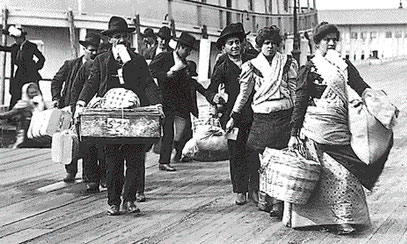Ellis Island: U.S. immigration policy of the late nineteenth and early twentieth century

“[In 1889] Secretary of the Treasury William Windom…reported ‘grave difficulties in the execution of [immigration] law through State agencies...’ There were jurisdictional disputes and “serious differences in the settlement of the accounts of certain State commissions.” The secretary recommended that the whole business of immigration control be assumed by the federal government…[A new] “joint committee on immigration, formed in the meantime…approved the selection of Ellis Island as the site for the new [federal] immigration station.”
- Thomas Pitkin, Keepers of the Gate, pp. 12-13
I visited Ellis Island yesterday…It was choked, and a half a score of gravid liners were lying uncomfortably up the harbour, replete with men, women, children, dirt, and bags together…All day long, through and intricate series of metal pens, the long procession files, step by step, bearing bundles and trunks and boxes, pen by pen, towards a desk at a little metal wicket –the gate of America…The great majority are young men and women, between seventeen and thirty, good, youthful, hopeful peasant stock…All day that string of human beads waits there, jerks forward, waits again, all day and every day, constantly replenished…till the units mount to hundreds and the hundreds to thousands…pouring in, finding work at once, producing no fall in wages. They start digging and building and making. Just think of the dimensions of it!
…Will the reader please remember that I’ve been just a few weeks in the States altogether, and value my impressions at that! And will he, nevertheless, read of doubts that won’t diminish. I doubt very much that America is going to assimilate all she is taking in now…America is, to my mind, “biting off more than she can chaw” in this matter.
I told these doubts to a pleasant young lady of New York, who seems to find much health and happiness in settlement work on the East Side. She scorned my doubts…
“In the end,” I said, “you Americans won’t be able to resist it.”
“Resist what?”
In those crowded noisy East Side streets one has to shout and shout compact things. “This,” I said to the barbaric disorder about us. “Lynching,! Child labor! Graft!”
Then we were separated by a heap of decaying fish that some hawker had dumped in the gutter. “We’ll tackle it! [she said.]
I looked at her, bright and courageous and youthful…I could have imagined her the spirit of American incarnate.
- H.G. Wells, The Future in America [1906], pp. 33-35,106, 110, 112

“…Much of the debate surrounding Ellis Island was not as polarized as we might imagine. Despite the heated rhetoric…there was considerable consensus on immigration. Most Americans found themselves in the political middle on the issue…Few Americans argued for a completely open door to all immigrants and few argued for their complete exclusion…The laws that dealt with European immigrants…were in marked contrast to the law direct towards Chinese immigrants [which] was one of restriction. This proved the exception to the larger rule of immigration regulation…Prejudice against southern and eastern Europeans certainly existed, but it was not written into the law until the quotas of the 1920s.
- Vincent Cannato, American Passage, pp. 10-12.
“…The United States in 1907 enacted its final piece of significant qualitative immigration regulation under a policy regime of fundamentally open “gates” towards Europe. Once again, the country had opted for more control instead of noticeably higher hurdles at those gates…
- Drew Keeling, The Business of Transatlantic Migration, p. 195
“…The protracted campaign for the literacy test is etched in historical memory as a prelude to the radically restrictive and racially oriented immigration laws of the 1920s…Of itself it was hardly invidious, since such a device was widely advocated by reformers for all Americans as a condition of membership in the political nation by way of the vote. Nevertheless, its advocates were full aware that its restrictive effect would fall mainly on “new immigration” from eastern and southern Europe.
…Yet despite its rapid endorsement by the intellectual establishment as well as by leading politicians, it took thirty years for the literacy test to become law. Why the lengthy delay?
…The vagaries of the legislative process largely arose from the contest between the “visible hand” seeking to maximize its labor supply, and the defenders of the
established boundaries of national identity. As it played itself out in the political arena, the confrontation was mediated by the party managers pursuit of the immigrant vote…”
- Aristide Zolberg A Nation by Design, pp. 200-01
 Mass migration
as a travel business
Mass migration
as a travel business
